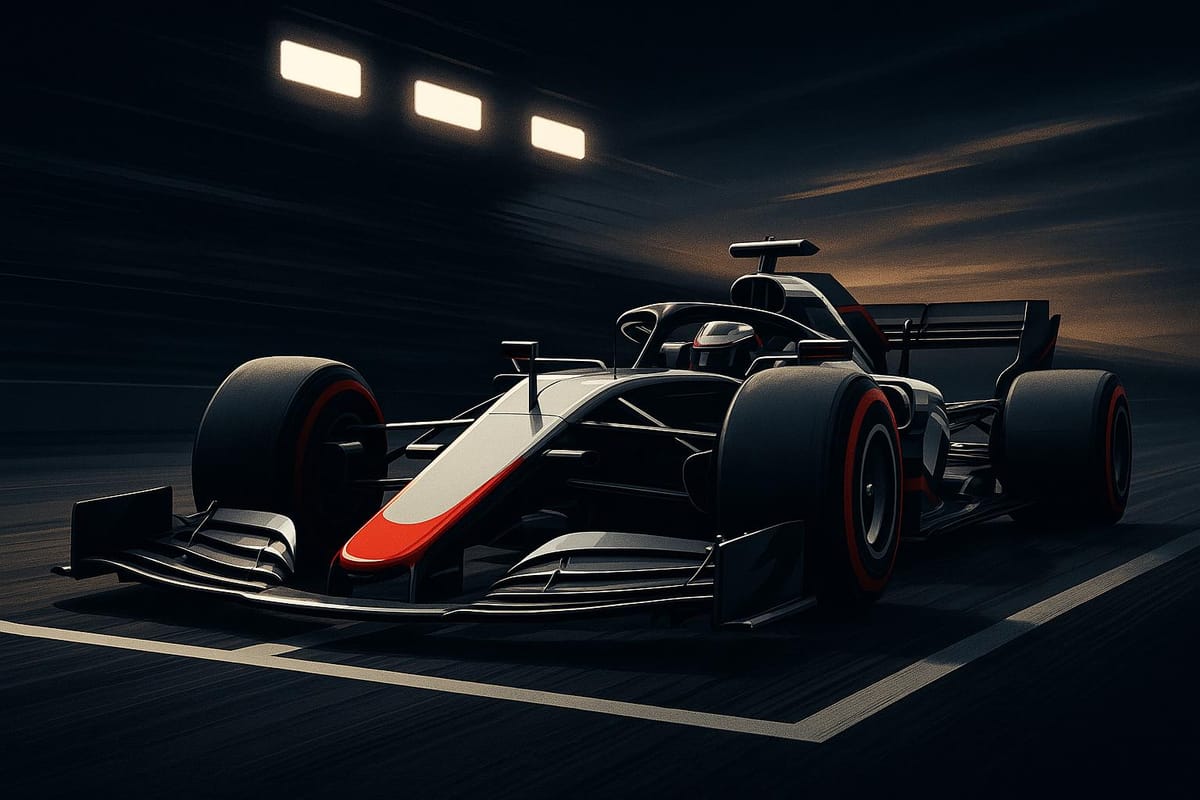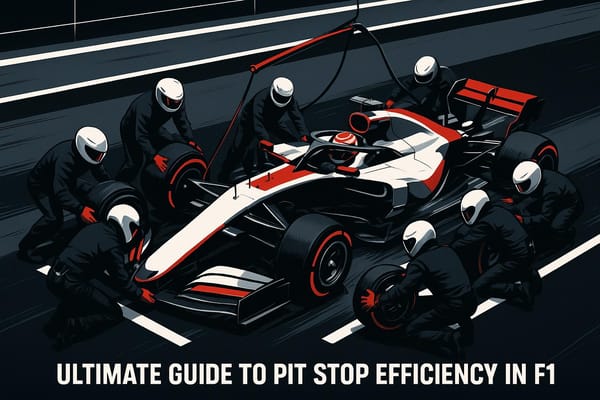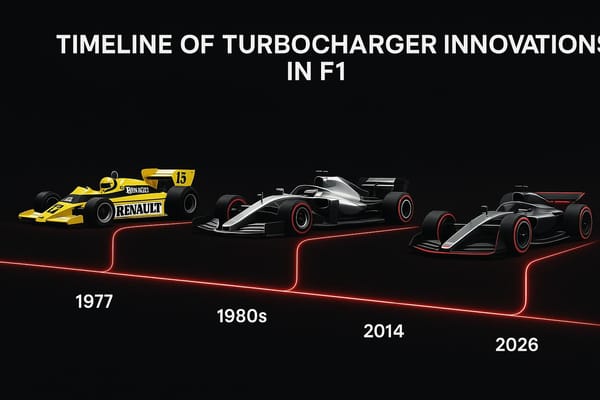Does Qualifying Predict Race Results?
Qualifying positions significantly predict race results in Formula 1, but race-day strategies and unpredictable factors can disrupt this correlation.

Short Answer: Yes, qualifying is the best predictor of race results in Formula 1. Data from 7,800 race weekends shows that starting position strongly correlates with finishing position, especially in the turbo-hybrid era (2014–2022). However, race-day factors like penalties, weather, pit stops, and crashes often disrupt this link.
Key Takeaways:
- Qualifying is critical: In modern F1, qualifying position predicts race outcomes better than practice sessions or starting grid positions altered by penalties.
- Turbo-hybrid era stats: A 0.756 correlation (Spearman's ρ: 0.777) shows qualifying's growing importance due to cars being harder to overtake.
- 52% of drivers finish where they qualify: This is higher than previous eras but still leaves room for surprises.
- Track and weather influence matters: Circuits with limited overtaking (e.g., Monaco) make qualifying more important, while rain or safety cars can shuffle results.
- Practice 3 insights: P3 is the most reliable practice session for predicting race outcomes, with a 0.674 correlation.
Why It’s Not a Guarantee:
- Penalties: Engine or gearbox changes can drop drivers down the grid, making qualifying times less relevant.
- Strategy and incidents: Tire management, pit stop timing, and crashes can flip the script on race day.
- Weather: Rain can expose weaknesses in cars or drivers who excel in dry qualifying conditions.
While qualifying is the best indicator of performance, it’s only part of the story. Race-day strategy, adaptability, and luck still play huge roles in determining who takes the checkered flag.
Data Analysis: Qualifying Position vs Race Results
An analysis of 7,800 driver-weekend observations over two decades sheds light on the connection between qualifying performance and race results in Formula One.
What the Numbers Show
The findings highlight that qualifying performance is the most reliable predictor of race outcomes, outperforming factors like starting grid position or practice session results.
Using contingency coefficients and Ordinal Logistic Regression, qualifying consistently stands out as the top indicator of performance across different Formula One eras.
| Era | Correlation (C) | Spearman's ρ | Relative Frequency |
|---|---|---|---|
| V8 (2006–2008) | 0.628 | 0.589 | 0.557 |
| KERS (2009–2013) | 0.744 | 0.745 | 0.478 |
| Turbo-Hybrid (2014–2022) | 0.756 | 0.777 | 0.519 |
The turbo-hybrid era (2014–2022) shows the strongest link between qualifying and race results, with a contingency coefficient (C) of 0.756 and Spearman's ρ of 0.777 (p < 0.001). In this period, qualifying positions predicted race outcomes with greater accuracy than in earlier eras. This trend reflects how modern Formula One has evolved to place even more emphasis on qualifying.
During the turbo-hybrid era, drivers finished in the same position as they qualified in about 52% of cases. While this might not seem overwhelming, it marks a noticeable improvement from the KERS era, where the figure was 47.8%.
The growing importance of qualifying is tied to changes in the sport. Modern F1 cars, with their advanced aerodynamics, make overtaking more challenging. At the same time, the gap between the top teams has narrowed, making qualifying performance a critical differentiator. Teams now allocate significant resources to improving Saturday results, knowing that track position on Sunday plays a decisive role.
Qualifying times are often considered an "unbiased measure" of a driver and car's true capability. Unlike starting grid positions, which can be affected by penalties or technical issues, qualifying times provide a cleaner baseline for predicting race results.
These trends set the stage for a deeper look at how track layouts and weather conditions can influence the qualifying-to-race relationship.
How Different Tracks and Weather Change the Pattern
Although qualifying is generally the strongest predictor, factors like track design and weather can shift the equation.
Tracks with ample overtaking opportunities - such as those with long straights, multiple DRS zones, or wide racing lines - reduce the influence of qualifying. Drivers at these circuits can recover from poor qualifying positions through on-track battles. On the other hand, circuits with limited overtaking zones make starting position more critical, reinforcing the importance of qualifying.
Weather conditions also play a role. For example, rain can disrupt the usual dynamics, as tire performance and car handling become unpredictable. A driver who excels in dry qualifying sessions might struggle in wet race conditions, leading to unexpected outcomes despite a strong Saturday showing.
Take the Marina Bay Circuit, home of the Singapore Grand Prix, as an example. The unique combination of night racing and a highly technical layout demands specific strategies for tire management and race execution. These factors can weaken the usual link between qualifying and race results, creating opportunities for surprises.
While qualifying remains the most consistent predictor of race outcomes, its reliability varies depending on external factors. These nuances help explain why Formula One continues to deliver unexpected twists, even when Saturday's results seem to establish the pecking order for Sunday.
What Breaks the Qualifying-to-Race Connection
While qualifying results often provide a strong indication of race performance, real-world factors can disrupt this connection. A great performance on Saturday doesn’t always translate to success on Sunday, thanks to a mix of penalties, strategy shifts, and unpredictable events.
Grid Penalties and Rule Violations
Grid penalties can completely alter a driver’s starting position, making qualifying speed less relevant to race outcomes.
For example, changes to engine components or gearboxes often come with penalties. A full power unit replacement can drop a driver several places, while replacing a gearbox typically costs five grid spots. Even if a driver posts an impressive qualifying lap, these penalties can push them far down the order.
Violations during qualifying itself can also shake things up. Drivers exceeding track limits or causing incidents may see their lap times deleted or face additional penalties. This creates a gap between their actual pace and their starting position. Imagine a driver setting the second-fastest time but starting much further back due to penalties - while their qualifying time reflects their speed, it no longer aligns with their race-day prospects.
Late penalties add another layer of complexity, often forcing teams to rethink their race strategies. A driver expecting to start near the front might need to switch from an aggressive, front-running game plan to a more defensive approach aimed at damage control.
Beyond penalties, race outcomes are further shaped by race-day decisions and unpredictable events.
Race Day Changes: Strategy, Pit Stops, and Crashes
Even when qualifying sets the tone, what happens on race day can completely change the story. Strategy, pit stops, and unforeseen incidents often override any advantage gained on Saturday.
Tire strategy is a game-changer. Teams that manage their tires well can gain track position over faster qualifiers. For example, a driver starting on a more durable tire compound might stay out longer while others pit, gaining crucial positions. On the flip side, an overly ambitious strategy can backfire if tire degradation sets in earlier than expected.
Pit stops are another critical factor. A flawless, well-timed stop can help a driver recover from a poor qualifying performance, while a slow or botched stop can squander any advantage gained. Timing is especially important during safety car periods or in heavy traffic, where a perfectly executed stop can make or break a race.
Crashes and mechanical failures are the ultimate wild cards. A driver starting from pole could find their race over within the first few laps due to a collision or technical issue. Similarly, safety car deployments can completely reset the field, erasing gaps and putting slower cars back in contention. Drivers who had commanding leads may find their advantage wiped out, while those further back suddenly have a shot at the podium.
Weather changes add yet another twist. A driver who excelled in dry qualifying conditions might struggle if it rains during the race, while others who underperformed in the dry could thrive in the wet.
All these factors show why qualifying, while important, is only part of the equation. Race day is shaped by strategy, execution, and the unpredictable nature of motorsport, making Sunday’s results far from guaranteed based on Saturday’s performances.
Practice Sessions and Race Pace Matter Too
Beyond qualifying, practice sessions and consistent race pace offer a broader view of a team's potential. While qualifying often steals the spotlight, practice sessions provide crucial insights into race-day performance, helping identify which drivers might exceed expectations when it matters most.
Using Practice Sessions to Predict Results
Among the practice sessions, Practice 3 (P3) stands out as the most reliable predictor of race outcomes, with a correlation coefficient of 0.674. This is because P3 acts as the final fine-tuning opportunity before qualifying. Earlier sessions, like Practice 1 (P1) and Practice 2 (P2), show weaker correlations (0.300 and 0.324, respectively), as they are primarily used for initial testing and experimentation.
However, interpreting practice data isn't straightforward. Teams often follow different agendas during these sessions, which can skew direct comparisons. For example, some teams might simulate race conditions with heavy fuel loads, while others focus on qualifying setups with minimal fuel. Additionally, teams may deliberately hold back their true pace to avoid revealing their strategies to competitors, adding another layer of complexity to the analysis.
Race predictions remain challenging due to unpredictable factors like weather, incidents, and strategic decisions. These variables highlight why even the most advanced analyses can't fully account for race-day surprises. Understanding practice data, however, sets the stage for examining the critical differences between sustained race pace and single-lap speed.
Race Pace vs. Qualifying Speed
While practice sessions help refine car setups, race pace focuses on performance over extended periods. Qualifying is all about the fastest single lap, but races demand consistency across 50-70 laps, often under challenging conditions like tire wear and changing track dynamics. This forces teams to strike a balance during practice between optimizing for short-term qualifying speed and long-term race performance.
Drivers like Lewis Hamilton and Sergio Pérez have demonstrated the importance of race pace in overcoming less-than-ideal starting positions. Lewis Hamilton has frequently turned subpar qualifying results into victories by leveraging Mercedes' strong race pace and his exceptional tire management skills. Sergio Pérez, known for his ability to conserve tires and execute strategic overtakes, has often climbed from mid-pack to podium finishes on race day.
To prepare for race conditions, teams analyze long-run data from practice sessions. This includes studying tire degradation, fuel consumption, and ideal pit stop windows. Such insights allow teams to craft adaptable race strategies. For instance, a driver who excels at tire management in practice might start on a harder compound, aiming to outlast competitors and gain positions through strategy.
Track evolution adds another layer of complexity to interpreting practice and race pace data. As rubber builds up on the track throughout the weekend, lap times improve, and car behavior shifts. Additionally, temperature changes between practice and race day can impact tire performance and aerodynamic efficiency, making predictions based on practice data less reliable.
The most successful teams use practice sessions to prepare for a variety of scenarios. They experiment with different wing configurations, tire compounds, and fuel loads to understand how their car performs under diverse conditions. This level of preparation proves invaluable during unexpected race-day events, enabling teams to adapt quickly and make informed decisions under pressure.
How Teams Plan Around Qualifying Results
Qualifying results play a pivotal role in shaping a team's race-day strategy, impacting everything from tire choices to pit stop timing. Data consistently shows that a driver's starting position is one of the strongest indicators of their race outcome. This forces teams to carefully balance their efforts to secure a favorable grid spot with their broader strategic goals.
Why Starting Position Matters in Modern F1
The complex aerodynamics of modern Formula One cars have made overtaking increasingly challenging, turning qualifying sessions into critical moments for championship contenders. Statistics from the turbo-hybrid era (2014–2022) reveal a much stronger link between qualifying positions and race results compared to earlier periods, like the V8 era (2006–2008).
Teams have adapted their strategies accordingly, treating qualifying as the purest test of single-lap performance, free from race-day penalties or unforeseen disruptions. This focus often means tweaking car setups specifically for qualifying, even if it compromises race-day performance. The payoff is clear: starting on the front row gives teams the ability to control race pace and defend their position, while starting further back forces them into riskier strategies, such as aggressive pit stops or unconventional tire choices.
Track characteristics also play a major role. Circuits like Monaco, Hungary, and Singapore, known for limited overtaking opportunities, place an even greater premium on qualifying performance. At these venues, a poor showing on Saturday can all but eliminate any chance of a podium finish. Teams account for these variables in their preparations, knowing that success in qualifying can significantly reduce race-day risks.
Choosing Between Quick Results and Long-Term Goals
While securing a strong starting position is critical, teams must also weigh the long-term implications of their qualifying strategies. Striking a balance between immediate gains and resource preservation is a constant challenge in Formula One.
McLaren Racing, for instance, has demonstrated this balance well. Even after clinching their 10th constructors' championship in October 2025, CEO Zak Brown emphasized the importance of maintaining a competitive strategy rather than shifting to a conservative approach.
This approach influences decisions like engine usage during qualifying. Teams often have to decide whether to run engines in high-power modes or use fresh power unit components earlier than planned to secure a better grid position. In tight championship battles, these decisions can be make-or-break, as they sometimes result in penalties down the line.
Tire management is another critical factor. With a limited number of tire sets available for the weekend, teams must decide whether to push hard in qualifying and risk depleting their race-day tire options or accept a slightly lower starting position to preserve their best rubber for Sunday.
The decision-making process becomes even more intricate when future race schedules and regulation changes come into play. For example, with new regulations looming in 2026, teams must decide how much effort to invest in short-term qualifying performance versus redirecting resources toward developing next-generation cars.
Weather conditions add yet another layer of complexity. Teams must weigh the risks of an all-out qualifying effort in unpredictable weather, such as rain, against a more conservative approach that saves equipment but might compromise their grid position. These decisions often separate the top teams from the rest, as the most successful organizations excel at contingency planning to adapt to changing circumstances. Ultimately, the way teams plan around qualifying remains a cornerstone of their overall race strategy, directly linking Saturday's performance to Sunday’s outcomes.
Final Answer: Does Qualifying Predict Race Results?
An analysis of 7,800 driver-weekend observations reveals that qualifying position is the most reliable predictor of race results. The correlation between qualifying and race outcomes stands at 0.756 in the turbo-hybrid era, compared to 0.628 during the V8 era. This growing connection highlights how modern Formula 1's intricate aerodynamics have made overtaking harder, elevating the importance of Saturday's qualifying session in shaping Sunday’s results.
However, race day is rarely predictable. While qualifying provides a strong indication of potential performance, factors like grid penalties, pit stop strategies, weather conditions, and mechanical failures can shake things up. A prime example is the 2020 Turkish Grand Prix, where Lance Stroll, starting from pole, missed the podium due to tire issues and changing track conditions.
Practice sessions, particularly Practice 3, also play a role in forecasting race outcomes, with a correlation of 0.674. This shows that examining the entire weekend - not just qualifying - offers a fuller picture of performance potential.
For the most accurate race predictions, it’s essential to consider all variables from the weekend. While qualifying reflects raw performance, incorporating practice data and track-specific nuances - like Singapore's night races or circuits with limited overtaking opportunities - provides a more comprehensive view.
FAQs
How do track conditions and weather influence the link between qualifying positions and race outcomes in Formula 1?
Track characteristics and weather conditions heavily influence how qualifying results translate into race day performance in Formula 1. On tight, twisty circuits, starting at the front is often a major advantage since overtaking opportunities are scarce. In contrast, tracks with long straights and multiple passing zones give drivers further back on the grid a better chance to climb through the field.
Weather throws another wrench into the mix. Rain can completely shake up the advantage of starting at the front, as it shifts the focus from car performance to driver skill and strategy. Additionally, changes in track temperatures can affect tire behavior, adding another layer of complexity to maintaining or improving qualifying positions during the race.
How do penalties and race-day strategies impact race results compared to qualifying positions?
Penalties and race-day strategies can completely shake up the results in Formula One, even for drivers who start with strong qualifying positions. Things like grid penalties, tire selection, pit stop timing, and how teams react to safety car periods can all play a big role in determining where a driver finishes.
Take tire management or a perfectly timed pit stop, for instance - both can give a driver a crucial advantage. On the flip side, unexpected penalties or a poorly executed strategy can send them tumbling down the order. These ever-changing variables are what make Formula One so thrilling to watch, proving that qualifying is just one part of the bigger picture.
Is qualifying performance a reliable predictor of race results in Formula 1?
The connection between qualifying performance and race results in Formula 1 is influenced by a mix of factors like the era of the sport, track layout, and team strategies. Starting at the front of the grid often gives drivers an edge, but it’s far from a guarantee of victory. Variables such as tire strategy, unpredictable weather, and on-track incidents can easily change the course of a race.
In earlier eras, when overtaking was more challenging, qualifying positions carried greater weight. However, modern developments like the Drag Reduction System (DRS) and more dynamic race strategies have made overtaking easier, shifting the emphasis slightly. Qualifying remains a crucial element, but it’s just one part of the equation when it comes to securing a win.




